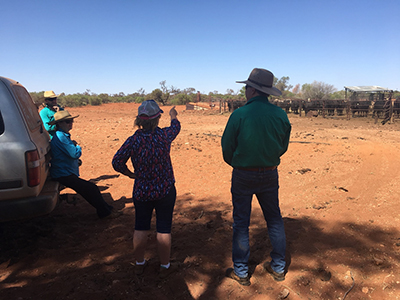CASH kicks off
Recently, the department had the opportunity to once again host Bruce Maynard, a passionate farmer and co-developer of the Maynard and Revell self herding and self shepherding management practices.
Part of the Central Australian Self Herding (CASH) five year project funded by Meat and Livestock Australia, Bruce, accompanied by Pastoral Extension Officer Meg Humphrys, visited Lyndavale and Palmer Valley Stations to discuss how self herding could assist them by solving problems through animal behaviour.
The self herding method uses stress free stockmanship to get desired outcomes. Anxious, stressed cattle can cause production losses on properties - particularly in the transport phase of the production system. Cattle in Central Australia typically travel a long way to market and ensuring they are as stress free as possible for the journey ahead will help them quickly get back onto feed and water at the other end.
One of the stress free stockmanship methods was demonstrated through an active de-stressing activity with the cattle in the yards. The activity is designed to get them more relaxed and alert to what the humans are trying to tell them, as well as drinking and eating without a fuss. Ensuring the cattle are not anxious is key to making the principles work.
CASH is designed to also help get cattle to stay at new waters or venture into ungrazed or less grazed areas that are not their home range by using ’attractant stations‘. This is particularly useful in dry times when producers may be opening up new water points. Some producers already use lick and other supplements to get cattle to stay in new yards for a few days to let them know their new home isn’t so bad. However, self herding takes it one step further by adding visual, audio and smell cues, taken from their old home water, to establish a sense of familiarity while diversity is also at play.
Self herding has been successful in Western Australia and at Kidman Springs in the Victoria River District in changing the ‘home range’ of cattle. Cattle, much like humans are creatures of habit and unless encouraged to venture out, they are unlikely to change - even if stressed from lack feed in their normal grazing areas. Self herding principles help cattle transition to new areas or feed on their own accord before conditions get too tough reducing the stress on you and your herd.

Above: Bruce talking to producers in the yard about actively de-stressing the cattle.
More information
- Visit the self herding website and the Kidman Springs self herding trial page on the FutureBeef website.
To secure a spot on Bruce’s next visit at the end of September contact:
Meg Humphrys
Pastoral Extension Officer
